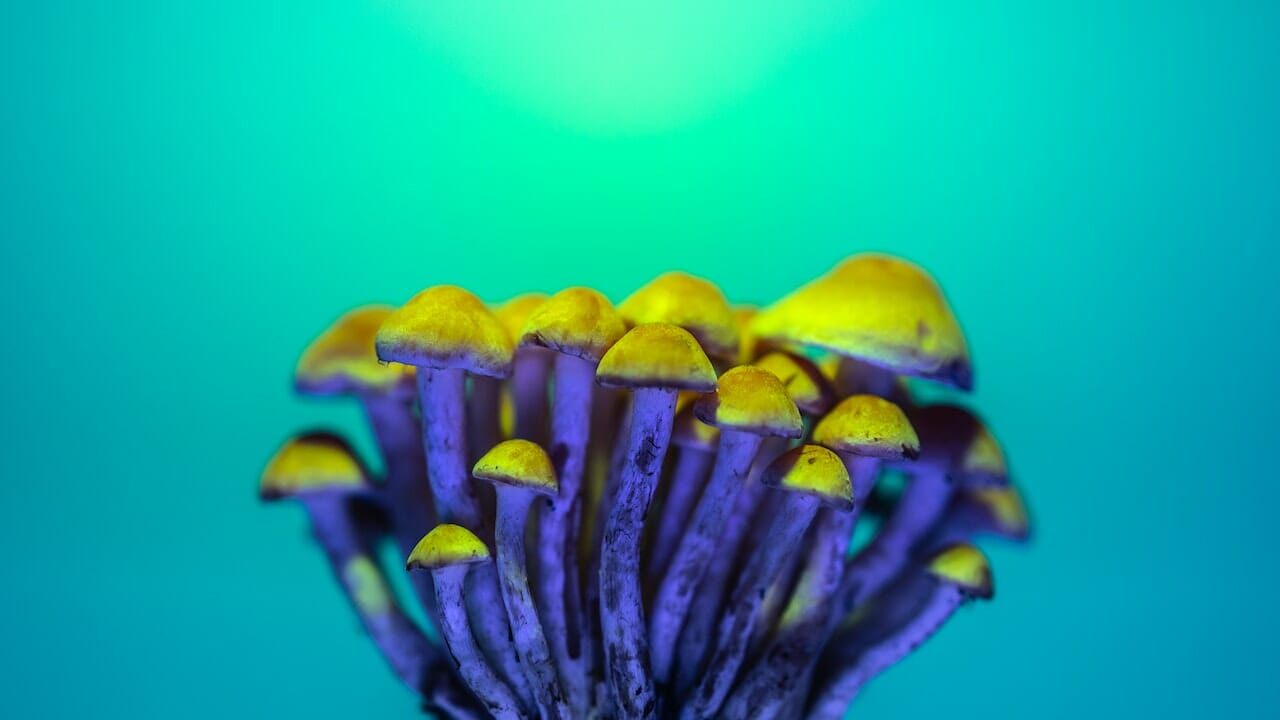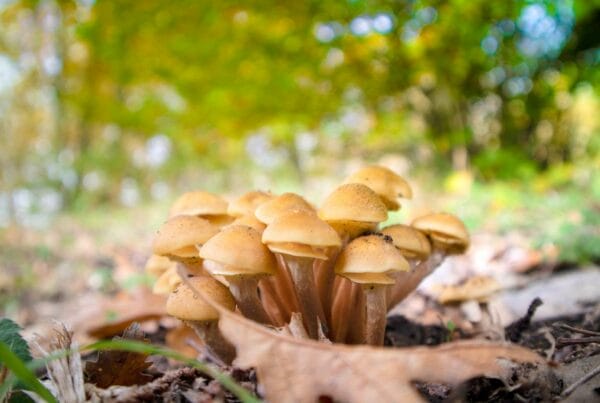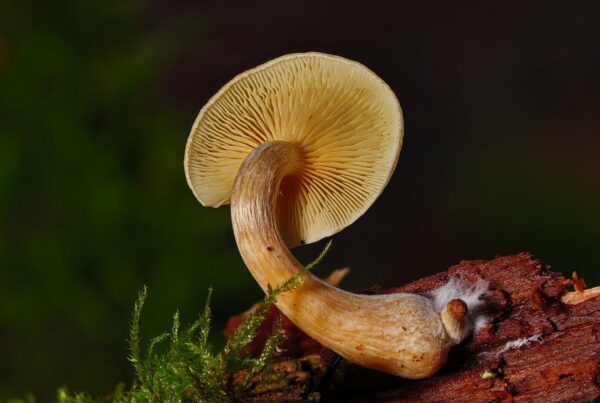Lysergic acid diethylamide (LSD) is a powerfully potent hallucinogen that has been thoroughly researched within the realm of psychedelic substances. Although initially identified for recreational purposes, LSD has evolved into a psychoactive substance with possible mental health advantages. This change in understanding has led to a new path of research into the effects of more user-friendly forms of LSD, such as LSD edibles.
Key Takeaways:
- LSD, a strong hallucinogen, originates from the ergot fungus.
- LSD shares properties with psilocybin and interacts with 5-HT2A receptors.
- Effects of LSD include mood swings, visual changes, ego dissolution, and pseudo-hallucinations.

Deciphering LSD
LSD is an exceptionally powerful hallucinogen that can dramatically transform a person’s perception of reality and significantly warp the senses. LSD originates from “ergot,” a fungus that grows on rye and other grains.
At its core, LSD is a complex chemical belonging to the ergoline family, featuring a hexahydroindole group and a quinoline group (lysergic acid). Its name ‘Lysergic Acid Diethylamide’ derives from the functional group linked to its core. LSD’s structure resembles other ergoline alkaloids, such as ergotamine found in the ergot fungus Claviceps purpurea, and the neurotransmitter serotonin.
The Influence of LSD
Upon consumption, LSD penetrates the brain and instigates chemical reactions that can persist for numerous hours. The following short-term effects may be caused by LSD:
- Unforeseen mood fluctuations
- Distorted perception
- Vertigo
- Decreased appetite
- Lack of control over movements
The Advantages What are the Benefits of Using LSD?
The benefits derived from LSD use are diverse and significantly influenced by the amount ingested. Most studies highlight the positive impacts associated with moderate consumption of this psychedelic compound. In the following sections, we explore the benefits linked to LSD use.
Pain Management and Neuronal Development
Researchers at Maastricht University discovered that a single microdose of LSD can produce pain-relieving effects that persist for at least five hours, if not longer.
In the Cold Pressor Test, where participants immerse their hands in water at a temperature of 3°C (37.4°F) for as long as possible, those who took 20 mg of LSD were able to withstand the cold for 20% longer than those who did not. They also reported feeling less pain and discomfort.
Furthermore, LSD can contribute to the development and growth of the brain’s 86 billion neurons. Moderate LSD doses, ranging from 5 to 20 ug, increase blood plasma BDNF levels. This is notable as mood disorders like depression, often associated with neuroplasticity issues, could be improved due to LSD’s beneficial effects on neuronal health.
Improves Mental Health
Dr. Robin Carhart-Harris from Imperial College London introduced the entropic brain hypothesis. According to this theory, mental health issues may stem from rigid thought patterns, perpetuated by an excessively active default mode network (DMN). Psychedelic substances like LSD can disrupt the DMN, increase brain entropy, and aid in dismantling harmful neural pathways while promoting the development of beneficial ones.
A study involving over 1,000 microdosers reported a decrease in depression. Another broad cross-sectional study showed a decrease in negative moods and destructive attitudes, as well as an increase in open-mindedness and cognition.
Helps in Treating Addiction
A meta-analysis of randomized-controlled clinical trials involving LSD in psychiatry concluded that it is most effective for treating alcohol addiction. This conclusion is supported by the successful results observed in patients treated for alcoholism by Humphrey Osmond and at the Spring Grove Hospital Centre in the 1950s and 1960s.
Relieves End-of-Life Anxiety and Depression
Research conducted by Dr. Peter Gasser suggests that LSD-assisted psychotherapy can aid terminally ill cancer patients in managing their end-of-life anxiety, while also enhancing their perceived quality of life. A Phase 2 trial is currently underway to further explore the potential impact of LSD therapy on depression.
Decoding LSD Edibles: Their Ingredients and Manufacturing Procedure
LSD edibles are a type of food or beverage that contain the hallucinogenic compound, LSD. They come in a variety of forms, including chocolates, candies, baked goods, and even unconventional items like LSD-infused mints.
Composition
- LSD: This is the active ingredient that triggers hallucinogenic effects. It is carefully measured and incorporated into the edible.
- Edible Base: Here, the LSD is typically either dissolved or infused into an edible medium like a gummy, candy, or sugar cube. These mediums act as carriers for the hallucinogenic compound.
- Flavouring and Ingredients: Depending on the specific edible product, flavourings, sweeteners, and other ingredients are added to enhance the taste and texture. These may include natural or artificial flavourings, colouring agents, and sugars, among others.
Manufacturing Method:
- LSD Synthesis: The first step involves the chemical production of LSD, which requires extensive knowledge of organic chemistry and access to the necessary chemicals, equipment, and a laboratory environment.
- Liquid Formulation: After the LSD is synthesized, it is typically converted into a liquid form by dissolving it in a solvent, creating a concentrated LSD solution.
- Infusion: The liquid LSD is then infused into an edible base such as gummy candies, sugar cubes, or blotter paper. The base absorbs the liquid, allowing for oral consumption of the LSD.
Exploring the Psychedelic Effects of Psychoactive Substances in LSD Edibles
LSD can trigger intense visual effects. Colours may seem brighter, objects might appear haloed or rainbow-tinged, and shapes can distort. Users may experience these visuals whether their eyes are open or closed.
LSD provides a path to alter the user’s perception of self and environment. It can induce a variety of psychological states, with thoughts appearing either clear and profound or disjointed and illogical. Other effects can include altered perception of time, distance, and body image. The line between self and the external world may become obscure. Some users report sensory crossover, such as seeing music or hearing colours.
Suggested LSD Products
While numerous LSD edibles are available, it’s vital to buy from a trustworthy dispensary. Make sure that the edibles contain LSD and not other substances like PCP (embalming fluid), ecstasy, or ketamine.
Deadhead Chemist – LSD Infused Gummies
Deadhead Chemist offers LSD-infused edibles, with each containing 100 micrograms (ug) of LSD, available in assorted flavours. Each packet includes one gummy, which has demonstrated potential in assisting individuals with conditions like obsessive-compulsive disorder (OCD), post-traumatic stress disorder (PTSD), alcoholism, depression, and cluster headaches.
Deadhead Chemist – Mint Tea
Deadhead Chemist’s raspberry mint tea presents a more pleasant and flavourful way to experience the effects of LSD. LSD and similar psychedelics imitate the serotonin neurotransmitter and increase the brain’s flow state.
Earthly Delights – Candy Flips
Candy flipping became famous during the rave scene of the late 1980s. Nowadays, explorers and party-goers continue to enjoy the combination of these two powerful substances. Users often experience deep feelings of love and unity, accompanied by captivating visual effects like intensified colours, object transformation, and complex geometric patterns.
Concluding Remarks
LSD has traditionally been linked with profound personal transformation. As our scientific comprehension of this substance has grown, so too has its popularity, and the advent of LSD edibles has opened up a fresh approach for users. These appealing morsels have gained
Explore LSD in a secure and pleasurable manner with carefully measured dosages.
Magic Mushrooms Calgary Canada, Canada’s leading supplier of high-quality shrooms online, provides an extensive array of LSD-infused edibles and cannabis products. Peruse our product range at your convenience, add your chosen items to your cart, and unwind at home while we handle the delivery. We also offer a diverse assortment of psilocybin shrooms, edibles, drinks, and capsules for your ease. Remember to check out our LSD delivery page for additional details!
Frequently Asked Questions
How is LSD different from psilocybin?
FEATURES LSD PSILOCYBIN Origin Semi-synthetic chemical compound Naturally occurring in fungi Available Forms Tabs, microdots, liquid, gummies, blotter paper Dried mushrooms, capsules, teas, chocolates Potency Highly potent, microgram doses (ug) Varies based on mushroom species and preparation Onset and Duration Rapid onset (15-60 minutes), short duration (3-5 hours) Slower onset (30-60 minutes), moderate duration (4-6 hours)
How can one avoid unsatisfactory experiences with LSD?
- Choose Your Environment Wisely
- Prepare Your Mental State
- Start with a Small Dose
- Have a Trip Guide
- Create a Calm Setting
- Use Deep Breathing and Grounding Techniques
- Accept and Release
How long do the effects last?
The acid’s effects will begin to show between 30-60 minutes after ingestion. Those who are more sensitive to psychedelics may start to feel the effects Within a short span of 15 minutes, you can determine if you’ve ingested LSD. It typically takes about an hour to feel the effects. The pinnacle of the trip occurs roughly three hours into the experience. You may feel like time is slowing down and start experiencing hallucinations.
Be resilient, as it’s normal to experience a sense of detachment from reality at this point. The most intense part of the trip can last between 3 and 5 hours, after which the comedown phase continues for an additional 3 to 5 hours.
How does LSD interact with the human body?
The primary interaction of LSD is with the brain’s serotonin system, where it binds to and activates the 5-HT2A receptor. This action initiates a cascade of neurochemical and physiological responses. Several factors can influence the effects of LSD, which can differ significantly.
Does LSD exist in forms other than edibles?
Certainly, LSD is available in a variety of forms. The four main types of LSD products are blotter paper, liquid solutions, tablets or microdots, and gelatin sheets.
Suggested Readings:
| FEATURES | LSD | PSILOCYBIN |
| Origin | Semi-synthetic chemical compound | Naturally occurring in fungi |
| Available Forms | Tabs, microdots, liquid, gummies, blotter paper | Dried mushrooms, capsules, teas, chocolates |
| Potency | Highly potent, microgram doses (ug) | Varies based on mushroom species and preparation |
| Onset and Duration | Rapid onset (15-60 minutes), short duration (3-5 hours) | Slower onset (30-60 minutes), moderate duration (4-6 hours) |





